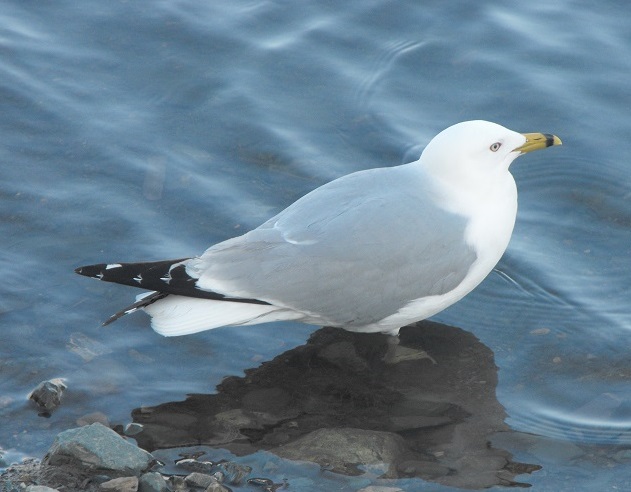
The Ring-Billed Gull (Larus delawarensis) is a monotypic species (no subspecies) classified in the order Charadriiformes and the family Laridae. This species gets its name from the black ring around its bill. The Ring-Billed Gull can live for up to 27.5 years.
Physical Characteristics
Adult Ring-Billed Gulls have gray backs, while their chests and bellies are white. They have yellow legs and bills. There is a black ring that encircles the bill. Juvenile Ring-Billed Gulls take a few years before they fledge into their adult plumage. Adult specimens have tan streaks across their heads in the nonbreeding season.
| Length | 43-54 cm(1’4.9″-1’9.3″) |
| Wingspan | 1.1-1.5 m(3’7.3-4’11.1″) |
| Weight | 300-700 gm(10.6 oz-1.5 lbs.) |
Range
The Ring-Billed Gull breeds throughout most of Canada; when Ring-Billed Gulls are in migration they can be seen in much of the northern half of the United States. During the nonbreeding season, Ring-Billed Gulls can be seen in much of the southern half of the United States. This species can occasionally be seen in Ireland and Great Britain.
Habitat
Ring-Billed Gulls inhabit harbors, lakes, and ponds. They can also be seen in more urban areas, such as landfills, parking lots, and sports fields.
Breeding
Ring-Billed Gulls nest in colonies; these colonies can number over 10,000 pairs. Ring-Billed Gulls build their nests on the ground near water. A lot of the time they pick sites under plants in order to hide them from other birds that intend to eat their eggs and chicks. Both the male and female build the nest. The nest is simply a scrape in the ground that is lined with twigs, sticks, grasses, leaves, lichens, or mosses. The outer diameter of the nest is about 25.4 to 63.5 cm (10”-2’1”), while the inner diameter is about 22.86 cm (9 inches) and the nest is 5.1 cm (2 inches) deep.
The clutch size is 2-4 eggs; the eggs are covered with brown speckles and are pale olive-gray in color. The eggs are 5-6.6 cm (2.0-2.6 inches) long and 3.6-4.6 cm(1.4-1.8 inches) wide. The incubation period is 20-31 days. When the chicks hatch out of the eggs, they are covered in gray and brown down feathers. The chicks open their eyes by the end of the first day after hatching.
Diet
Ring-Billed Gulls eat fish such as alewife, smelt, Nine-Spined Stickleback (Pungitius pungitius), and Yellow Perch (Perca flavescens). They also eat insects, including beetles, flies, and dragonflies. Some of the fruits consumed by Ring-Billed Gulls include dates, cherries, blueberries, and strawberries. Ring-Billed Gulls will also eat food thrown away by people.
Conservation Status
The Ring-Billed Gull is listed as least concern.
